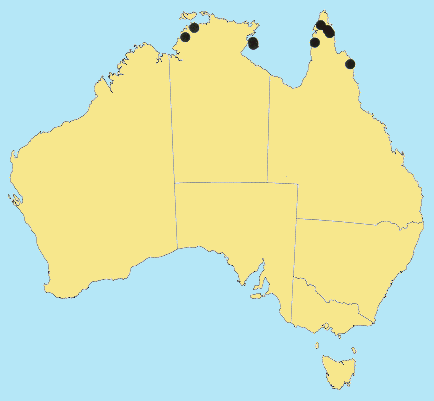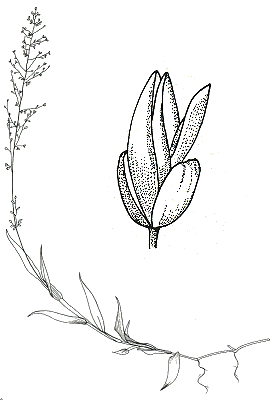Coelachne pulchella R. Br. Prodr. 187 (1810).
Classification. (GPWG 2001) : Subfamily Micrairoideae. Isachneae.
Key references (books and floras): [1810]. R.Brown, Prodromus (187), [1878] G.Bentham, Flora Australiensis 7 (626).
Habit. Annual. Culms geniculately ascending or decumbent, stature slender to delicate, 5–20 cm tall. Mid-culm nodes pubescent. Ligule a fringe of hairs or absent. Leaf-blades lanceolate, 0.8–3 cm long, 2–5 mm wide. Leaf-blade surface scaberulous.
Inflorescence. Inflorescence compound, a panicle. Panicle linear or oblong, 4–10 cm long.
Spikelets. Spikelets pedicelled. Fertile spikelets 2-flowered, both fertile, comprising 2 fertile floret(s), without rachilla extension, oblong or ovate, terete or dorsally compressed, 1.3–1.8 mm long.
Glumes. Glumes similar, thinner than fertile lemma. Lower glume elliptic or orbicular, membranous, without keels, 3–5 -nerved. Upper glume oblong or orbicular, 1–1.3 mm long, membranous, without keels, 3–7 -nerved. Florets. Fertile florets female (upper).
Fertile lemma 0.7–1 mm long, without keel, 0 -nerved. Anthers 2. Grain 0.6–0.8 mm long.
Continental Distribution: Tropical Asia and Australasia.
Australian Distribution: Northern Territory, Queensland.
Northern Territory: Darwin & Gulf. Queensland: Cook.
Notes. Inflorescence shape and spikelet shape distinguish it from other members of the genus.
Rare in tropical Australia. In tropical and subtropical sub-humid woodlands. Flowers July-Aug.




